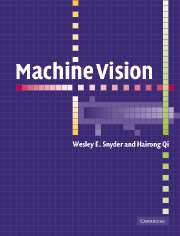Book contents
- Frontmatter
- Contents
- To the instructor
- Acknowledgements
- 1 Introduction
- 2 Review of mathematical principles
- 3 Writing programs to process images
- 4 Images: Formation and representation
- 5 Linear operators and kernels
- 6 Image relaxation: Restoration and feature extraction
- 7 Mathematical morphology
- 8 Segmentation
- 9 Shape
- 10 Consistent labeling
- 11 Parametric transforms
- 12 Graphs and graph-theoretic concepts
- 13 Image matching
- 14 Statistical pattern recognition
- 15 Clustering
- 16 Syntactic pattern recognition
- 17 Applications
- 18 Automatic target recognition
- Author index
- Index
15 - Clustering
Published online by Cambridge University Press: 05 June 2012
- Frontmatter
- Contents
- To the instructor
- Acknowledgements
- 1 Introduction
- 2 Review of mathematical principles
- 3 Writing programs to process images
- 4 Images: Formation and representation
- 5 Linear operators and kernels
- 6 Image relaxation: Restoration and feature extraction
- 7 Mathematical morphology
- 8 Segmentation
- 9 Shape
- 10 Consistent labeling
- 11 Parametric transforms
- 12 Graphs and graph-theoretic concepts
- 13 Image matching
- 14 Statistical pattern recognition
- 15 Clustering
- 16 Syntactic pattern recognition
- 17 Applications
- 18 Automatic target recognition
- Author index
- Index
Summary
Woes cluster; rare are solitary woes
Edward YoungIn this chapter, we approach the problem alluded to in Chapter 14 where the training set simply contains points, and those points are not marked in any way to indicate from which class they may have come. As in the previous chapter, we present only a brief overview of the field, and refer the reader to other texts [14.4, 15.7] for more thorough coverage. One very important area which we omit here is the use of biologically inspired models for clustering [15.4, 15.5, 15.6], and the reader is strongly encouraged to look into these.
We will discuss the issues of clustering in a rather general sense, but note one particular application, which is identification of peaks in the Hough transform array.
Consider this example from satellite pattern classification: We imagine a downward-looking satellite orbiting the earth, which, at each observed point, makes a number of measurements of the light emitted/reflected from that point on the earth's surface. Typically, as many as seven different measurements might be taken from a given point, each measurement in a different spectral band. Each “pixel” in the resulting image would then be a 7-vector where the elements of this vector might represent the intensity in the far-infrared, the near-infrared, blue, green, etc.
- Type
- Chapter
- Information
- Machine Vision , pp. 356 - 368Publisher: Cambridge University PressPrint publication year: 2004



